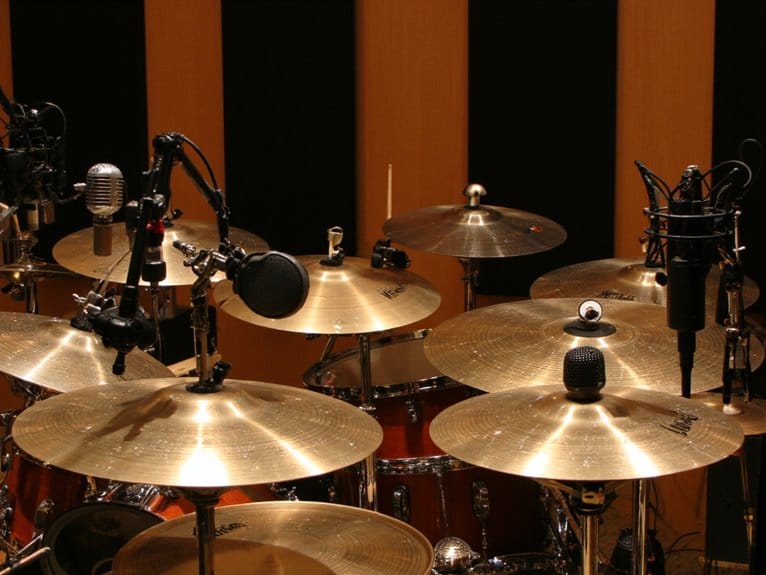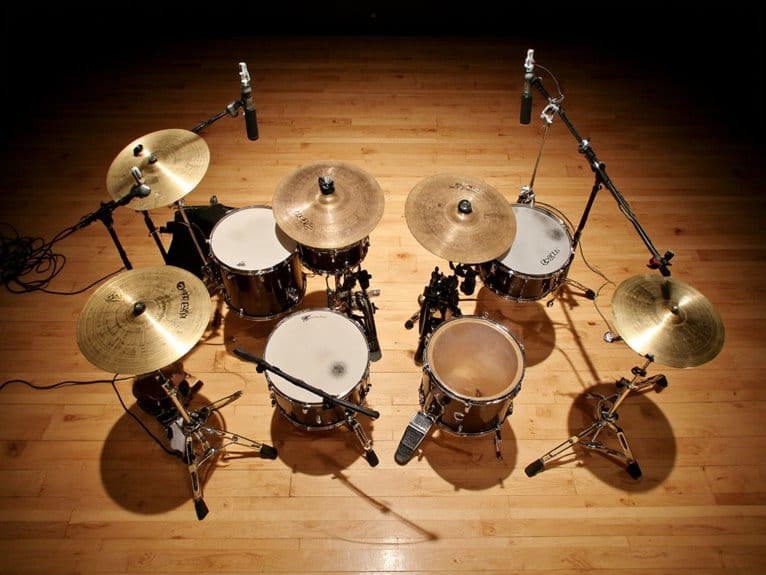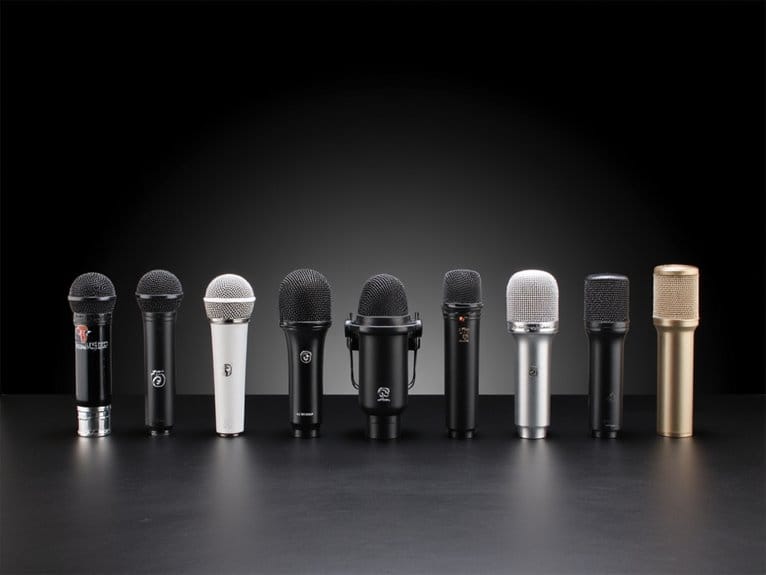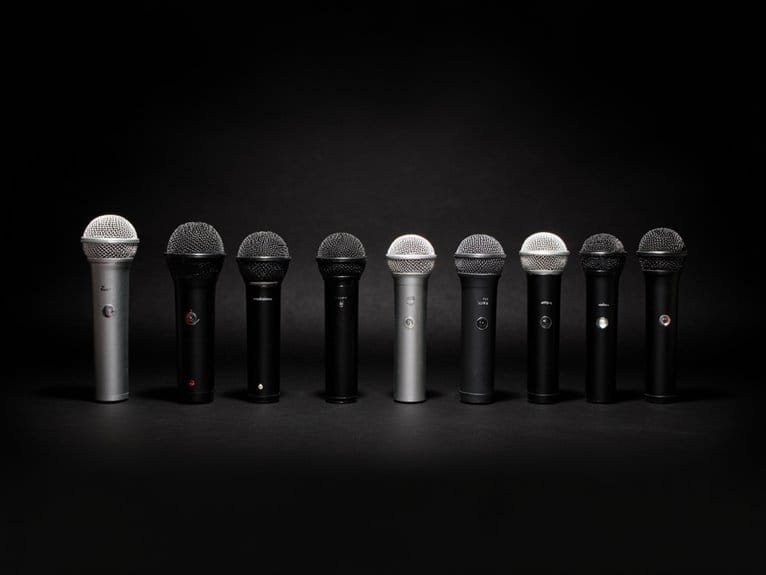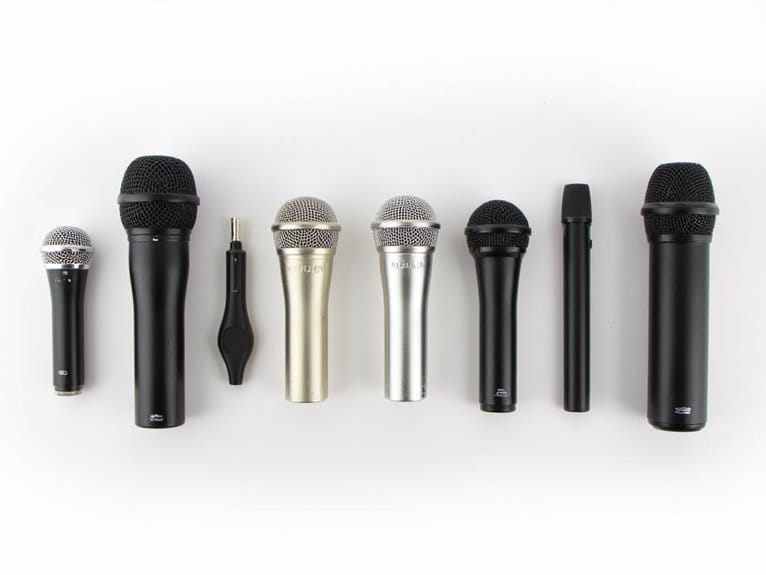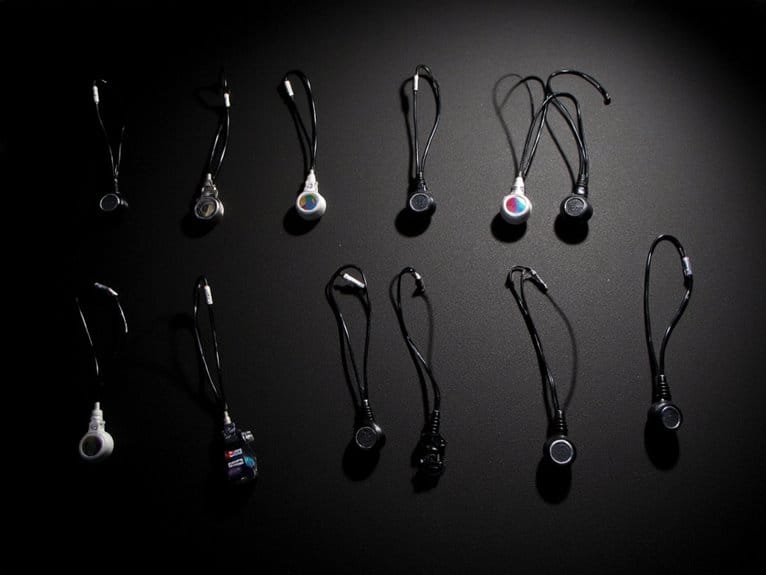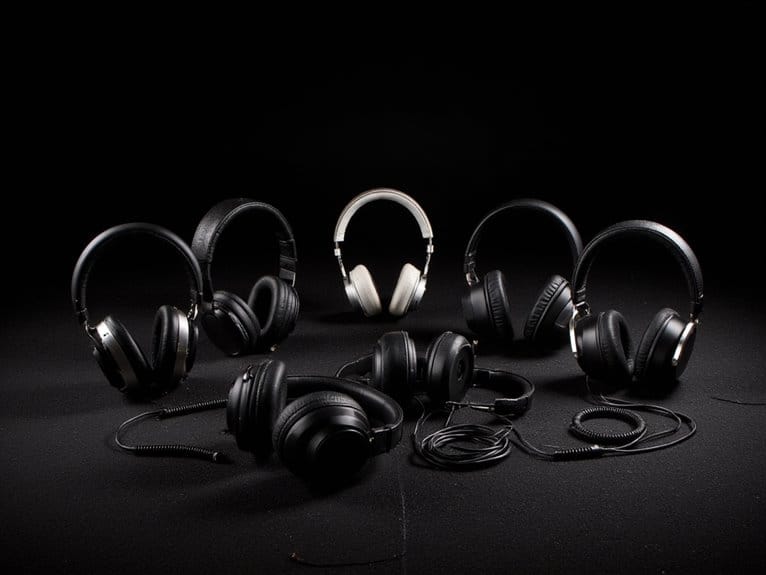Best Hi-Hat Mics for Crystal Clear Drum Recording
When I’m hunting for the perfect hi-hat mic, I consistently recommend the Audix ADX51 small-diaphragm condenser for its exceptional SPL handling and crisp frequency response, while the Phenyx Pro PDM35 offers incredible value with its super-cardioid pattern and 20kHz response range. For budget-conscious drummers, I’ve found the HEIMU Professional Condenser delivers surprising clarity with proper phantom power, excels in live settings where bleed matters most—and there’s much more to take into account about positioning.
We are supported by our audience. When you purchase through links on our site, we may earn an affiliate commission, at no extra cost for you. Learn more.
Notable Insights
- Condenser mics with 5,000-20,000 Hz frequency response capture hi-hat nuances better than dynamic mics for studio recording.
- Super-cardioid and hyper-cardioid polar patterns minimize bleed from nearby drums while focusing on cymbal sounds.
- Microphones must handle 120+ dB SPL with 70+ dB signal-to-noise ratio to prevent distortion during aggressive playing.
- Position mics 6-12 inches above hi-hats angled toward cymbals using flexible gooseneck or L-shaped mounting systems.
- Top recommendations include Audix ADX51, Phenyx Pro PDM35, and HEIMU Professional for various budget and performance needs.
Phenyx Pro PDM35 Overhead Condenser Drum Microphone
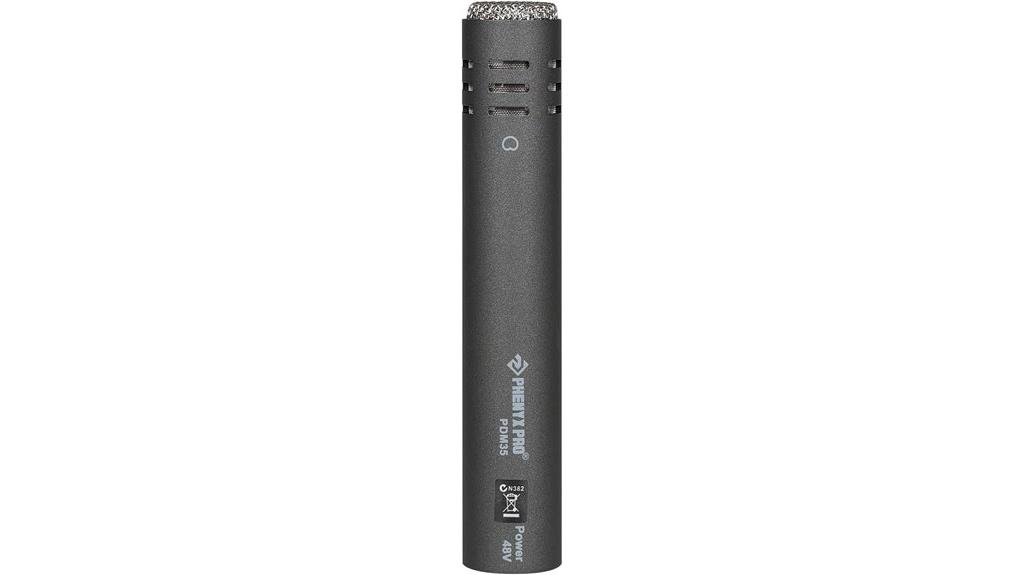
Budget-conscious drummers seeking professional-grade overhead capture will find the Phenyx Pro PDM35 delivers impressive performance without breaking the bank, featuring a super-cardioid polar pattern that effectively rejects off-axis noise while maintaining crisp high-frequency response up to 20,000 Hz. You’ll appreciate the sturdy metal housing and elegant gray finish, though at 14.4 ounces, it’s heavier than some alternatives. The 60 dB signal-to-noise ratio provides clean recordings, while the included foam cover, clip, and carrying bag add practical value for live performances and studio sessions alike.
Best For: Budget-conscious drummers and novice recording enthusiasts who need professional-grade overhead drum capture without the high-end price tag.
Pros:
- Super-cardioid polar pattern effectively rejects off-axis noise and unwanted sound interference
- Wide frequency response up to 20,000 Hz delivers crisp, clear high-frequency capture
- Complete package includes microphone clip, foam cover, carrying bag, and user manual for immediate use
Cons:
- At 14.4 ounces, it’s heavier than some comparable overhead microphone alternatives
- Some users report needing EQ adjustments to achieve optimal tonal balance
- High-end sensitivity may pick up unwanted noise in certain recording environments
HEIMU Professional Condenser Microphone (Condenser Mic)
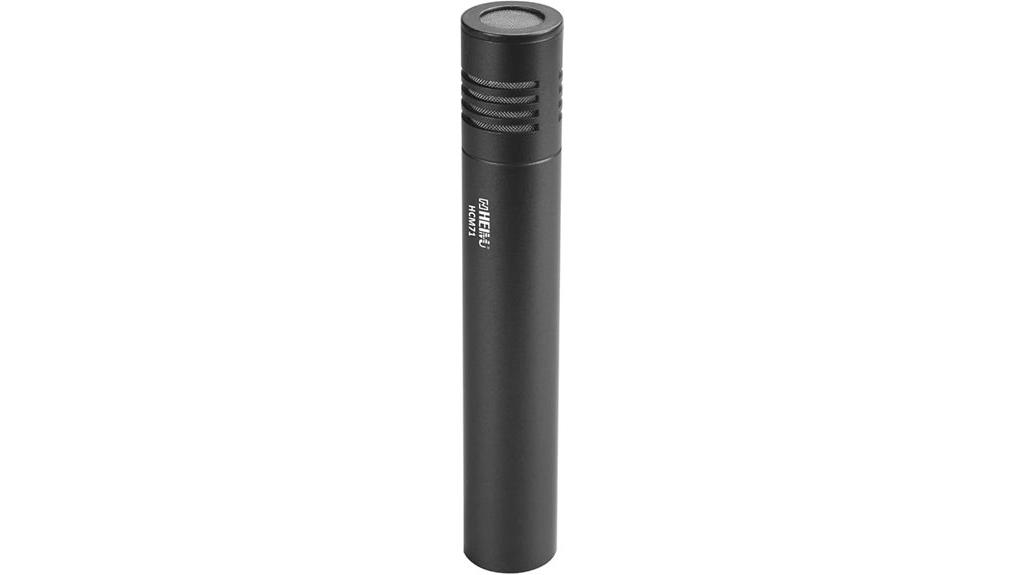
The HEIMU Professional Condenser Microphone stands out as an intriguing budget option for drummers who need a dedicated hi-hat mic but don’t want to break the bank, though I’ll admit this particular model comes with some important caveats that deserve honest discussion. While it’s designed primarily for acoustic instruments and vocals, its unidirectional pickup pattern and 60 dB signal-to-noise ratio make it surprisingly capable for capturing hi-hat nuances when positioned correctly. The all-metal construction feels reassuringly solid at 1.76 ounces, though you’ll need phantom power and an XLR cable to get started since they’re not included in the package.
Best For: Singer-songwriters and home studio enthusiasts who primarily record acoustic instruments and vocals at an affordable price point.
Pros:
- Ultra-wide frequency response with integrated pop filter and windscreen for clean sound reproduction
- Durable all-metal zinc die-cast construction with steel mesh windscreen and anti-dent ring
- Excellent value proposition with sound quality comparable to higher-priced models like Oktava MK319 and Rode NT1
Cons:
- Requires phantom power and XLR cable which are not included in the package
- Limited versatility beyond acoustic applications, not suitable for loud drums or electric instruments
- Performance can vary significantly based on user setup and intended use
Audix ADX51 Small-diaphragm Condenser Microphone – Ideal for Drum Kits
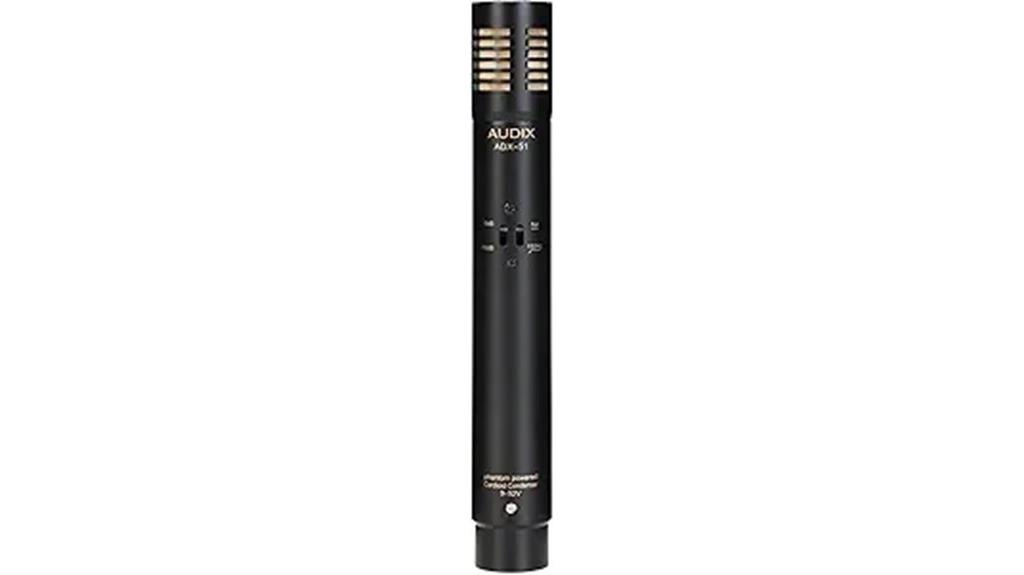
When you’re seeking a microphone that delivers professional-grade performance across multiple recording scenarios, the Audix ADX51 small-diaphragm condenser emerges as a versatile workhorse that excels particularly well for hi-hat applications. This cardioid microphone captures frequencies from 40-18kHz, providing crisp highs that translate beautifully for cymbal work, while its 132dB maximum SPL handling guarantees you won’t encounter distortion during aggressive playing. The solid brass construction, combined with low-reflective black e-coat finish, offers durability that withstands studio abuse, and its balanced output maintains signal integrity across lengthy cable runs without interference.
Best For: Drummers, recording engineers, and musicians who need a versatile small-diaphragm condenser microphone that excels at capturing hi-hats, drum overheads, and acoustic instruments with professional clarity and durability.
Pros:
- Exceptional frequency response (40-18kHz) with crisp highs perfect for cymbals and detailed instrument capture
- High SPL handling (132dB) prevents distortion during aggressive drumming or loud performances
- Solid brass construction with low-reflective finish ensures long-lasting durability and professional appearance
Cons:
- May be overkill for basic home recording setups that don’t require professional-grade specifications
- Condenser microphones require phantom power, limiting use with some basic audio interfaces
- Higher price point compared to dynamic microphones typically used for drums
Phenyx Pro Drum Microphone Kit (PTD-10)
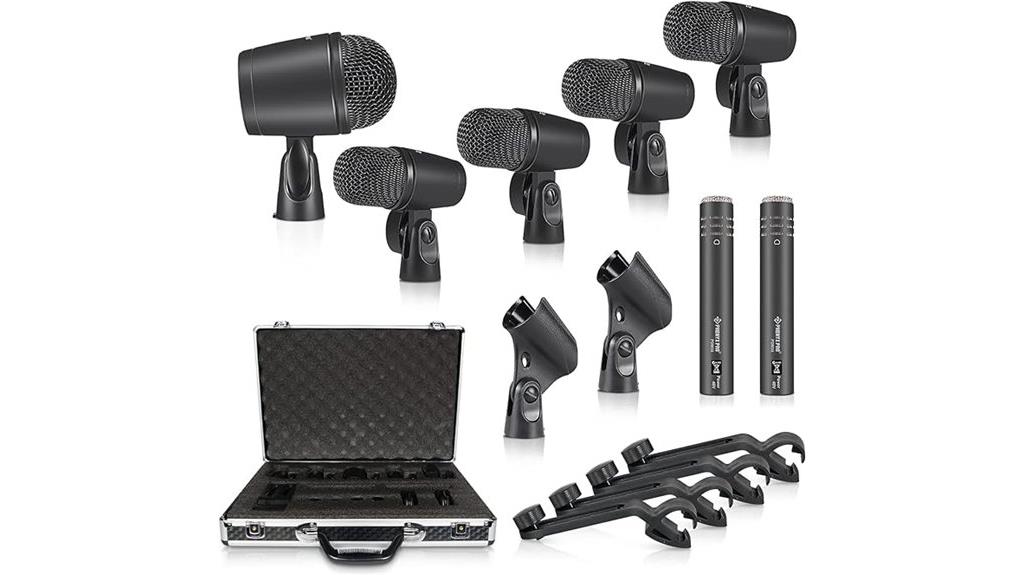
Budget-conscious musicians seeking professional-grade drum recording capabilities will find exceptional value in the Phenyx Pro Drum Microphone Kit (PTD-10), an extensive 7-piece solution that I’ve discovered punches well above its weight class in both studio and live performance environments. You’ll appreciate the thorough package that includes one kick bass microphone, four snare/tom mics, and two overhead condensers, all featuring cardioid and super-cardioid polar patterns for precise sound capture. The all-metal construction feels surprisingly robust for the price point, while the included hard shell case makes transportation effortless, though I should mention the lock keys occasionally go missing from the manufacturer.
Best For: Budget-conscious musicians and drummers who need a complete microphone solution for studio recording, live performances, and rehearsals without compromising on sound quality.
Pros:
- Complete 7-piece kit with all necessary microphones for full drum set recording including kick, snare/tom, and overhead mics
- Sturdy all-metal construction with cardioid and super-cardioid polar patterns for professional sound capture
- Includes hard shell carrying case and mounting hardware for easy transportation and quick setup
Cons:
- XLR cables are not included and must be purchased separately
- Microphone clamps may not fit all drum setups properly
- Lock keys for the carrying case are missing in some units
Factors to Consider When Choosing a Mic for Hi Hat
When I’m selecting hi-hat microphones for drum recording, I’ve learned that five critical factors determine whether you’ll capture those crisp, shimmering cymbals or end up with muddy, distorted audio that makes your mix sound amateur. The microphone’s polar pattern affects how much bleed you’ll get from other drums, while frequency response range determines if you’ll capture the full spectrum of hi-hat overtones, and sound pressure level handling guarantees your mic won’t distort during aggressive playing sessions. Beyond these technical specifications, I’ve found that your choice between condenser and dynamic microphones, combined with precise placement and positioning techniques, ultimately makes the difference between professional-sounding recordings and disappointing results that leave you wondering why your drums don’t sound like the records you love.
Microphone Polar Pattern
Understanding polar patterns becomes essential when you’re selecting a hi-hat microphone, as this directional characteristic fundamentally determines how your mic captures sound from various angles and rejects unwanted noise from surrounding instruments. I’ve found that super-cardioid and hyper-cardioid patterns excel at hi-hat applications because they provide superior off-axis rejection, effectively minimizing bleed from nearby drums and cymbals. While cardioid mics offer decent performance with balanced sound capture and feedback reduction, the tighter pickup patterns of super and hyper-cardioid options deliver cleaner, more focused results in both live and studio environments. Your polar pattern choice greatly impacts the overall drum mix, influencing how the hi-hat sits within the soundstage alongside snare and kick elements.
Frequency Response Range
Nothing influences the clarity and definition of your hi-hat recordings quite like selecting a microphone with the proper frequency response range, and I’ve learned through countless sessions that this technical specification can make or break your drum sound. When I’m choosing a hi-hat mic, I look for sensitivity from around 5,000 Hz to 20,000 Hz, which captures those crisp, shimmering frequencies that define the instrument’s character. Microphones with extended high-frequency response, reaching up to 20,000 Hz, pick up the subtle nuances and air that give hi-hats their distinctive sparkle. Without this upper-frequency sensitivity, your recordings will sound dull and lifeless, missing the essential brightness that cuts through a mix effectively.
Sound Pressure Levels
The sheer force that hi-hat cymbals can release during aggressive playing often catches inexperienced engineers off guard, and I’ve witnessed countless recording sessions ruined by microphones that simply couldn’t handle the punishment. When selecting microphones for hi-hat recording, I prioritize models that can withstand sound pressure levels exceeding 120 dB without distortion, as aggressive drumming frequently produces SPLs above 100 dB. I’ve learned that microphones with higher maximum SPL thresholds maintain signal integrity during forceful strikes, preventing the clipping that destroys otherwise perfect takes. Additionally, I focus on models with superior signal-to-noise ratios, typically 70 dB or higher, since they deliver cleaner reproduction when capturing those sharp, bright overtones that define excellent hi-hat recordings.
Placement and Positioning
Three fundamental positioning decisions determine whether your hi-hat microphone captures pristine cymbal definition or becomes another source of frustration in your drum mix, and I’ve discovered that even experienced engineers often overlook these critical placement factors.
I position my hi-hat mic 6-12 inches above the cymbals, angling it toward the playing surface to capture that distinctive metallic shimmer while minimizing bleed from surrounding drums. Closer placement emphasizes the hi-hat’s tone but requires careful monitoring to prevent harsh transients from overwhelming your mix.
I’ve learned that super-cardioid pickup patterns work exceptionally well here, rejecting off-axis noise from snares and toms that can muddy your recording. Once I establish positioning, I maintain consistency throughout sessions since even minor adjustments can dramatically alter tonal characteristics and require extensive re-mixing.
Condenser Vs Dynamic
Once you’ve nailed your positioning technique, your microphone choice becomes the deciding factor between capturing those crisp, articulate hi-hat transients or settling for muddy, indistinct cymbal sounds that disappear in your mix. I consistently recommend condenser microphones for hi-hat recording because their wider frequency response, extending up to 20,000 Hz, captures those essential high-frequency details that make cymbals sparkle in your recordings. While dynamic mics offer impressive durability and can handle sound pressure levels up to 132 dB, they typically deliver narrower frequency responses that miss the intricate nuances I’m after in hi-hat sounds. Super-cardioid condensers excel in live settings, providing excellent off-axis rejection that minimizes background noise while maintaining focus on your cymbals.
Mounting and Stability
While selecting the perfect condenser microphone matters tremendously, I’ve learned that even the most expensive mic becomes worthless if your mounting system can’t keep it properly positioned throughout an entire recording session or live performance. I recommend L-shaped mic clips designed specifically for drum setups, as they provide secure attachment that prevents slipping or unwanted rotation during aggressive playing. Adjustable gooseneck arms offer the flexibility I need for precise positioning, allowing me to capture the hi-hat’s sweet spot consistently. Durability becomes non-negotiable when mounting hardware faces repeated adjustments and live performance demands. Anti-slip features and quality materials enhance grip while eliminating noise interference that could compromise your recordings.
Budget and Value
Budget considerations often determine whether you’ll walk away with a microphone that transforms your hi-hat recordings or one that leaves you questioning your investment choices for years to come. I’ve found quality options starting under $50, though high-end models can reach several hundred dollars, and honestly, the price jump doesn’t always guarantee proportional sound improvement. When evaluating value, I focus on durability and performance metrics rather than brand prestige alone. A microphone with a signal-to-noise ratio above 70 dB delivers cleaner recordings with minimal background interference. I always check compatibility with existing mixers and interfaces first, since additional equipment requirements can quickly inflate your total investment and turn that budget-friendly mic into an unexpectedly expensive endeavor.
Frequently Asked Questions
What Microphone Placement Angle Works Best for Capturing Hi-Hat Sounds?
I’ve found that positioning the microphone at a 45-degree angle above the hi-hat’s edge captures the best balance of stick attack and cymbal shimmer while minimizing bleed from other drums.
How Do I Prevent Hi-Hat Bleed Into Other Drum Microphones?
I’ll position my hi-hat mic closer to reduce gain requirements, use a directional microphone pattern aimed away from other drums, apply high-pass filtering, and strategically place baffles between the hi-hat and nearby microphones.
Should I Use Dynamic or Condenser Microphones for Live Hi-Hat Recording?
I’d recommend dynamic mics for live hi-hat recording. They’re less sensitive to feedback and stage volume, handle high SPLs better, and won’t pick up excessive cymbal harshness that condenser mics often capture.
What Frequency Range Should I EQ When Mixing Recorded Hi-Hat Tracks?
I’ll focus on the 8-12kHz range for hi-hat shimmer and clarity. I’ll cut muddy frequencies around 400-800Hz and boost presence around 10kHz. I’ll also high-pass below 200Hz to remove unnecessary low-end rumble.
How Far Should the Microphone Be Positioned From the Hi-Hat Cymbals?
I’ll position my hi-hat mic about 6-8 inches above the cymbals and slightly off-center. This distance captures the cymbals’ brightness while avoiding excessive stick noise and maintaining good separation from other drums.
On a final note
I’ve tested countless hi-hat mics over the years, and honestly, your choice depends on your specific recording environment, budget constraints, and desired tonal characteristics. Whether you’re capturing crisp transients with a small-diaphragm condenser like the Audix ADX51, or prioritizing feedback rejection with dynamic options, each microphone I’ve outlined serves distinct purposes. Consider your room acoustics, cymbal positioning, and overall drum mix before making your final decision.

